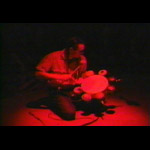Archer Pechawis
Performance
Memory
Western Front, Vancouver BC 1997



click images to view
In brief, "Memory" was an investigation into what "traditional" means in contemporary First Nations culture. The performance featured a hand drum wired to a sampler via MIDI, which enabled me to drop various audio samples in to the mix while I sang neo-traditional songs of my own composition. The primary samples used in this piece were from audiocassettes of my deceased grandfather Thomas Pechawis drumming and singing and videotaped interviews of two elders, Bill Lightbown (Kutenai) and Harriet Nahanee (Coast Salish) speaking to the issue of "what is traditional". Other audio sources included samples of Jimi Hendrix, Soundgarden, The O'Jays and The Fugees.
My artist statement, from the program notes:
"This performance investigates the notion of what constitutes 'traditional' Native drumming and singing through the use of a hand drum into which I have incorporated trigger pads that activate a digital sampler when struck. Simply put, if I drop a Motorhead sample into a round dance tune, is it still traditional? Cum on, feel the noize, heya heya ho..."
From an interview with Deanna Bowen, FRONT magazine, March/April 1997
"I am not a performance artist in the classic, art-school-graduate sense. I never went to art school, I don't have an art history/art theory understanding of things. Although we are theorizing about it, my relationship to the work isn't coming from a theoretical place. It's asking questions I really want some answers to. I want to de-colonize my soul. ... I've had native people tell me that the following things are 'traditional': heterosexism, patriarchy, the 'horns and pitchfork' devil, dark is evil/light is good, you name it. I know I have an idealized notion of pre-contact Indianness, but give me a break!"
"If we (Indians) are going to untangle ourselves from the mess we are in then some hard-assed questions have got to be asked. I am addressing these questions to the Aboriginal community for an internal debate. I'm not interested in non-Native peoples' thoughts on this matter. It's an Indian thing. And hopefully that will give us some room to breathe on this, cuz it doesn't have to be hashed out in a public sphere. It could be said that I'm contradicting myself because I am not presenting this work in a 'Native only' space, but I'm not looking for immediate responses. I think the issue of what is 'traditional' is going to be a long, long debate."
Format of the performance
I sat in the center of the performance space with the audience sitting on the floor around me in concentric circles. Chairs were set around the perimeter for elders and the infirm. Surrounding the performance space were four video monitors set at the cardinal directions and four stacks of PA speakers at the mid points between them, which reflected the design of the drum. The performance featured four songs, punctuated by four edited clips of the elders. At the end of the first video I sang a song inspired by the question and response. At the end of the first song another video section played. One video and song was played to each direction for a total of four videos and four songs.